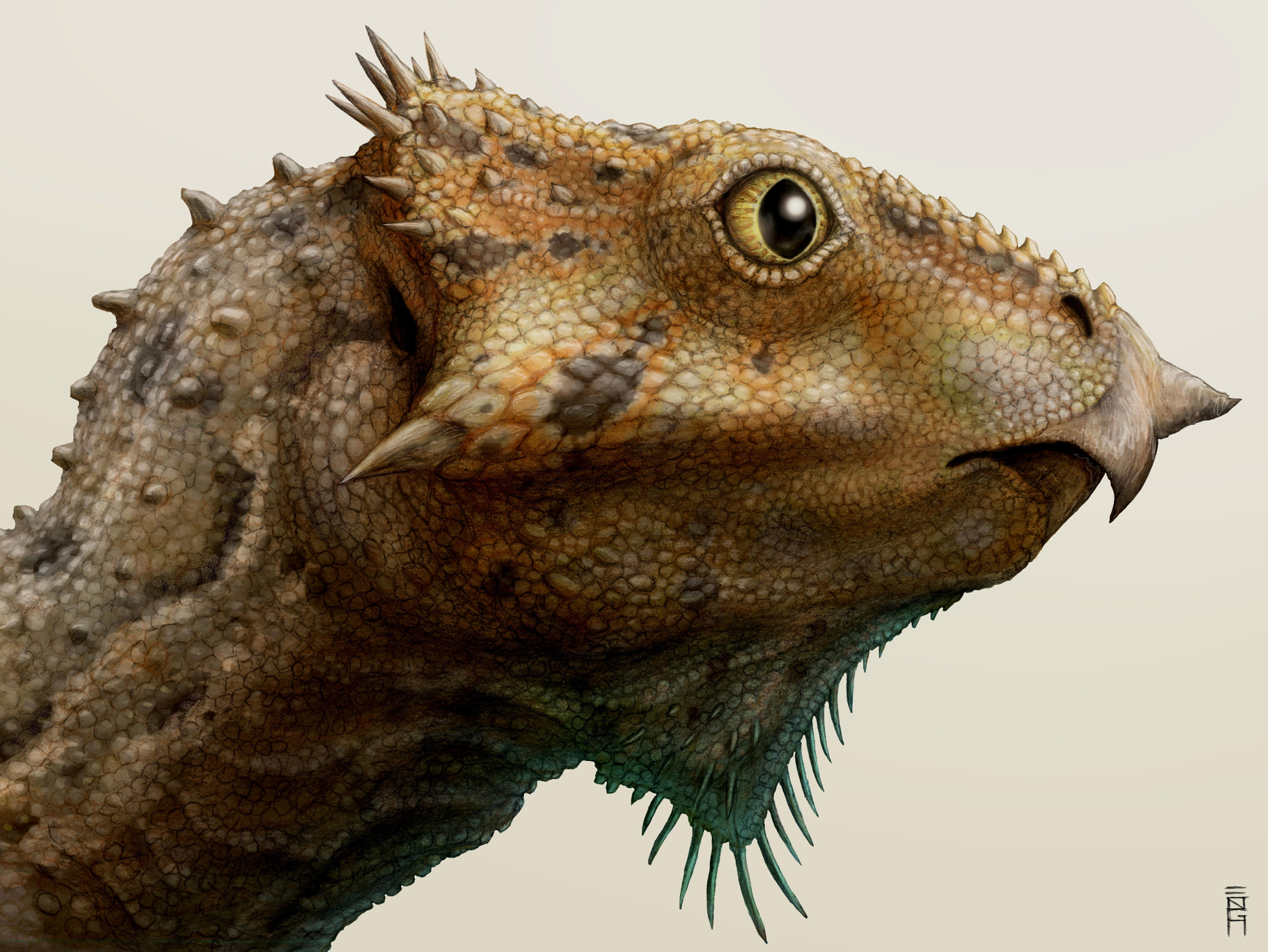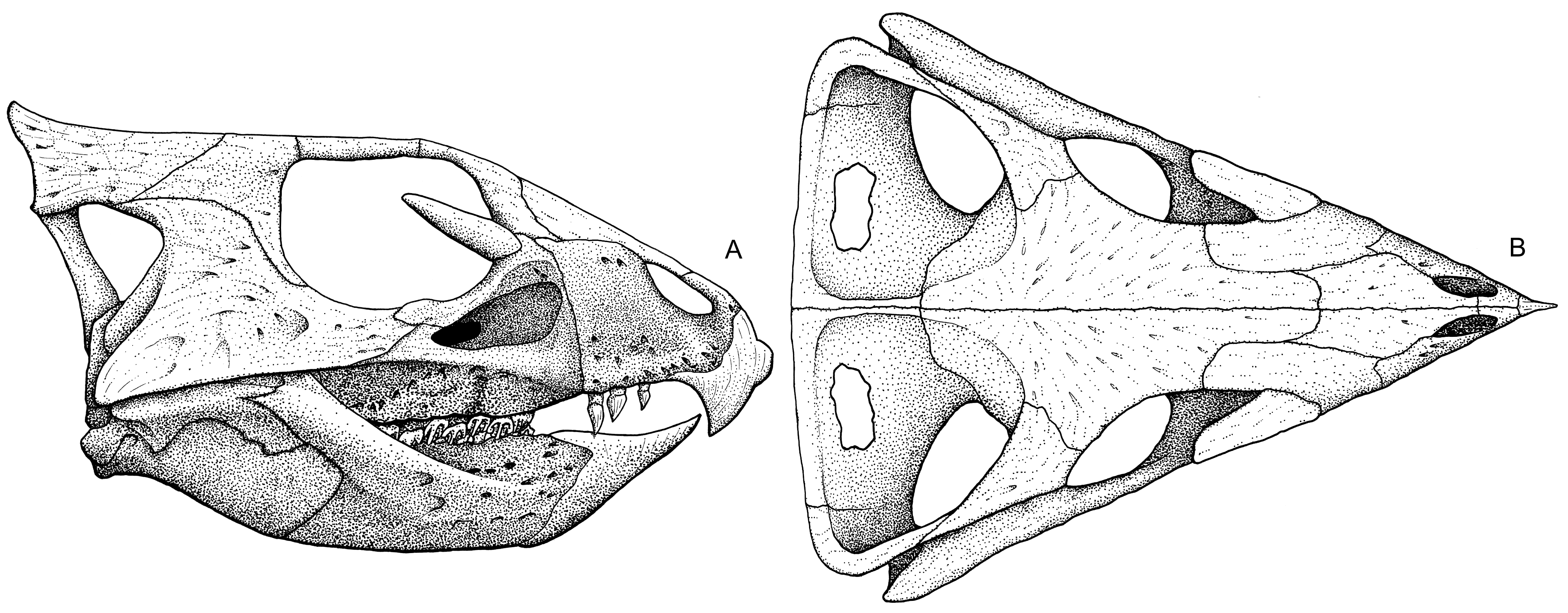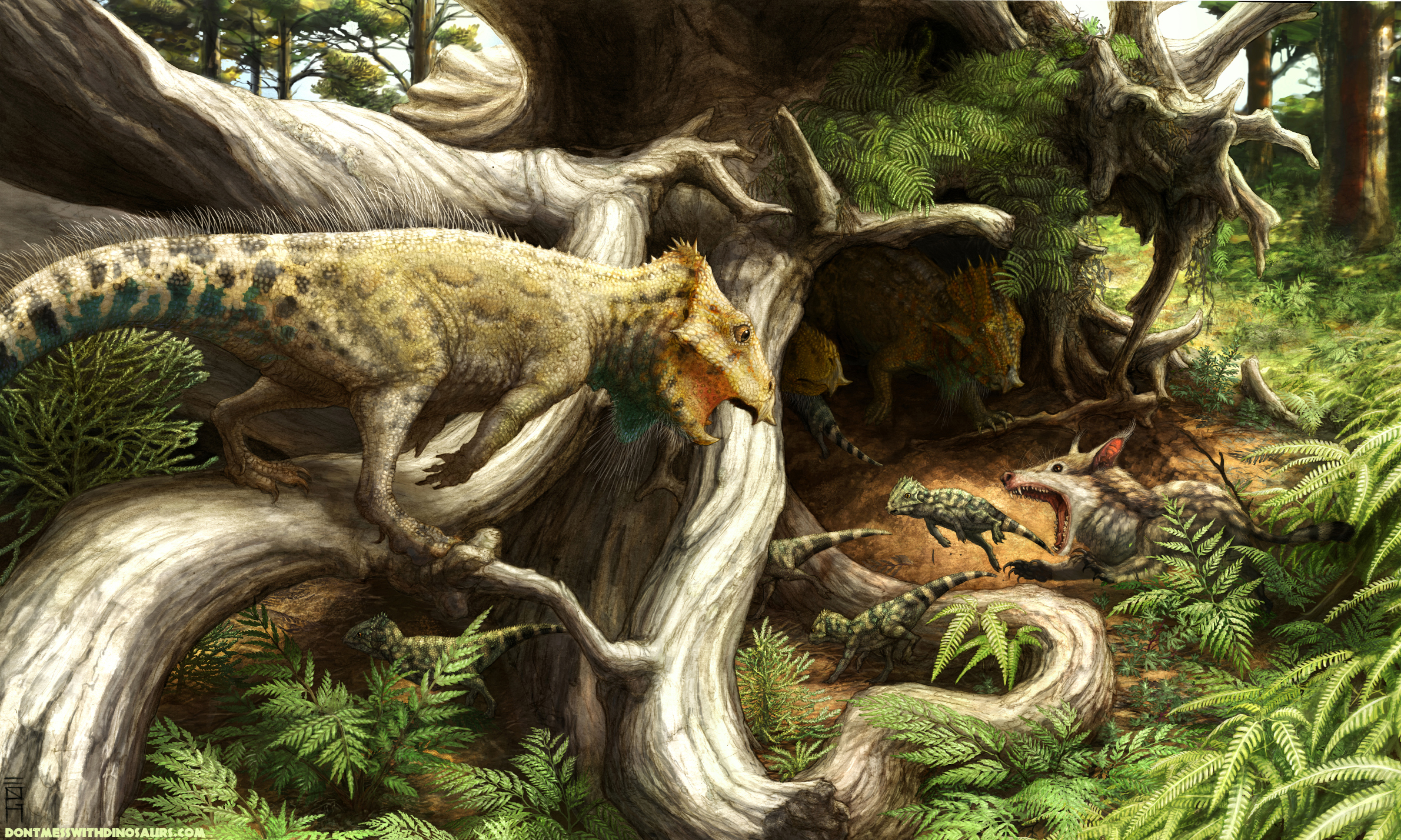Aquilops on:
[Wikipedia]
[Google]
[Amazon]
''Aquilops'' is an early herbivorous
 The skull is 84.2 mm long. The
The skull is 84.2 mm long. The
 In 1997,
In 1997,


 ''Aquilops'' was placed in the
''Aquilops'' was placed in the
The Sam Noble Museum
- Interactive 3d models of ''Aquilops'' skull and dinosaur. {{Taxonbar, from=Q18617035 Ceratopsia Dinosaur genera Albian dinosaurs Cloverly Formation Dinosaurs of the United States Fossil taxa described in 2014 Taxa named by Matt J. Wedel
ceratopsian
Ceratopsia or Ceratopia ( or ; Greek: "horned faces") is a group of herbivorous, beaked dinosaurs that thrived in what are now North America, Asia and Europe, during the Cretaceous Period, although ancestral forms lived earlier, in the Late Ju ...
dinosaur
Dinosaurs are a diverse group of reptiles of the clade Dinosauria. They first appeared during the Triassic Geological period, period, between 243 and 233.23 million years ago (mya), although the exact origin and timing of the #Evolutio ...
dating from the Early Cretaceous
The Early Cretaceous (geochronology, geochronological name) or the Lower Cretaceous (chronostratigraphy, chronostratigraphic name) is the earlier or lower of the two major divisions of the Cretaceous. It is usually considered to stretch from 143.1 ...
of North America
North America is a continent in the Northern Hemisphere, Northern and Western Hemisphere, Western hemispheres. North America is bordered to the north by the Arctic Ocean, to the east by the Atlantic Ocean, to the southeast by South Ameri ...
, approximately 109 million to 104 million years ago. The type species is ''A. americanus''.
Description
 The skull is 84.2 mm long. The
The skull is 84.2 mm long. The holotype
A holotype (Latin: ''holotypus'') is a single physical example (or illustration) of an organism used when the species (or lower-ranked taxon) was formally described. It is either the single such physical example (or illustration) or one of s ...
is possibly not from a full-grown individual. A comparison with related species indicates it might have been at 60% of its adult length. Wedel estimated the total body length of ''Aquilops'' at 60 cm and its weight at 1.5 kg.
The authors established some unique traits. The rostral
Rostral may refer to:
Anatomy
* Rostral (anatomical term), situated toward the oral or nasal region
* Rostral bone, in ceratopsian dinosaurs
* Rostral organ, of certain fish
* Rostral scale
The rostral scale, or rostral, in snakes and other sca ...
, the bone core of the snout beak, curves downwards and has an arched keel on its top with a bump on the front. In front of the tooth row the upper jaw rim is over its total length concave in side view. The skull opening, the antorbital fenestra
An antorbital fenestra (plural: fenestrae) is an opening in the skull that is in front of the eye sockets. This skull character is largely associated with Archosauriformes, archosauriforms, first appearing during the Triassic Period. Among Extant ...
, is twice as long as it is tall and has a pointed rear, below the eye socket.
Discovery and naming
 In 1997,
In 1997, paleontologist
Paleontology, also spelled as palaeontology or palæontology, is the scientific study of the life of the past, mainly but not exclusively through the study of fossils. Paleontologists use fossils as a means to classify organisms, measure geolo ...
Scott Madsen found the single fossil
A fossil (from Classical Latin , ) is any preserved remains, impression, or trace of any once-living thing from a past geological age. Examples include bones, shells, exoskeletons, stone imprints of animals or microbes, objects preserve ...
, a partial skull, in Carbon County in southern Montana
Montana ( ) is a landlocked U.S. state, state in the Mountain states, Mountain West subregion of the Western United States. It is bordered by Idaho to the west, North Dakota to the east, South Dakota to the southeast, Wyoming to the south, an ...
. While preparing the specimen, at first assumed to be of '' Zephyrosaurus'', he discovered that it was a species new to science.
In 2014 the type species
In International_Code_of_Zoological_Nomenclature, zoological nomenclature, a type species (''species typica'') is the species name with which the name of a genus or subgenus is considered to be permanently taxonomically associated, i.e., the spe ...
''Aquilops americanus'' was named and described by , W. Desmond Maxwell, Richard L. Cifelli, and Matt J. Wedel. The generic name is derived from Latin
Latin ( or ) is a classical language belonging to the Italic languages, Italic branch of the Indo-European languages. Latin was originally spoken by the Latins (Italic tribe), Latins in Latium (now known as Lazio), the lower Tiber area aroun ...
''aquila'', "eagle", and Greek ὤψ, ''ops'', "face", in reference to the beaked snout. The specific name ''americanus'' refers to the fact that the species represents the first unequivocal very basal neoceratopsian found in America.
The holotype
A holotype (Latin: ''holotypus'') is a single physical example (or illustration) of an organism used when the species (or lower-ranked taxon) was formally described. It is either the single such physical example (or illustration) or one of s ...
, OMNH 34557, was found in a layer of the Cloverly Formation, dating from the middle-late Albian
The Albian is both an age (geology), age of the geologic timescale and a stage (stratigraphy), stage in the stratigraphic column. It is the youngest or uppermost subdivision of the Early Cretaceous, Early/Lower Cretaceous epoch (geology), Epoch/s ...
. It consists of a skull with lower jaws, of a subadult individual. The rear of the head and the palate are the main lacking parts. The specimen was found during a 1997 expedition supported by the National Geographic Society
The National Geographic Society, headquartered in Washington, D.C., United States, is one of the largest nonprofit scientific and educational organizations in the world.
Founded in 1888, its interests include geography, archaeology, natural sc ...
and directed by Cifelli.
Classification


Neoceratopsia
Ceratopsia or Ceratopia ( or ; Greek: "horned faces") is a group of herbivorous, beaked dinosaurs that thrived in what are now North America, Asia and Europe, during the Cretaceous Period, although ancestral forms lived earlier, in the Late Ju ...
. A cladistic
Cladistics ( ; from Ancient Greek 'branch') is an approach to biological classification in which organisms are categorized in groups ("clades") based on hypotheses of most recent common ancestry. The evidence for hypothesized relationships is ...
analysis showed that it was positioned rather basal, below ''Leptoceratops
''Leptoceratops'' (meaning 'small horn face') is a genus of ceratopsian dinosaur from the Late Cretaceous of North America. First found in Alberta in 1910, the type species ''Leptoceratops gracilis'' was named in 1914 by Barnum Brown for a parti ...
'' in the evolutionary tree, with only ''Liaoceratops
''Liaoceratops'', meaning "Liaoning horned face", is a ceratopsian dinosaur believed to be an early relative of the horned ceratopsids. It lived in the Early Cretaceous, 126 million years ago. It was discovered in China by a team of American and ...
'' being more basal. A more derived position, e.g. as a leptoceratopsid or a protoceratopsid, was less likely; it was improbable that it was a ceratopsoid. The fact that the holotype was a subadult might have distorted these results because juvenile individuals often show basal traits. However, after correcting for traits that might change during ontogeny
Ontogeny (also ontogenesis) is the origination and development of an organism (both physical and psychological, e.g., moral development), usually from the time of fertilization of the ovum, egg to adult. The term can also be used to refer to t ...
, the resulting tree was basically the same. The ceratopsians more derived than psittacosaurids, called ''neoceratopsians'', evolved in Asia: the presence of a basal neoceratopsian in North America was seen as an indication for a late Early Cretaceous migration event, the ancestors of ''Aquilops'' invading from Asia. Two later such events would have occurred in the early Late Cretaceous
The Late Cretaceous (100.5–66 Ma) is the more recent of two epochs into which the Cretaceous Period is divided in the geologic time scale. Rock strata from this epoch form the Upper Cretaceous Series. The Cretaceous is named after ''cre ...
.
See also
* 2014 in paleontology *Neoceratopsia
Ceratopsia or Ceratopia ( or ; Greek: "horned faces") is a group of herbivorous, beaked dinosaurs that thrived in what are now North America, Asia and Europe, during the Cretaceous Period, although ancestral forms lived earlier, in the Late Ju ...
* Timeline of ceratopsian research
References
External links
The Sam Noble Museum
- Interactive 3d models of ''Aquilops'' skull and dinosaur. {{Taxonbar, from=Q18617035 Ceratopsia Dinosaur genera Albian dinosaurs Cloverly Formation Dinosaurs of the United States Fossil taxa described in 2014 Taxa named by Matt J. Wedel